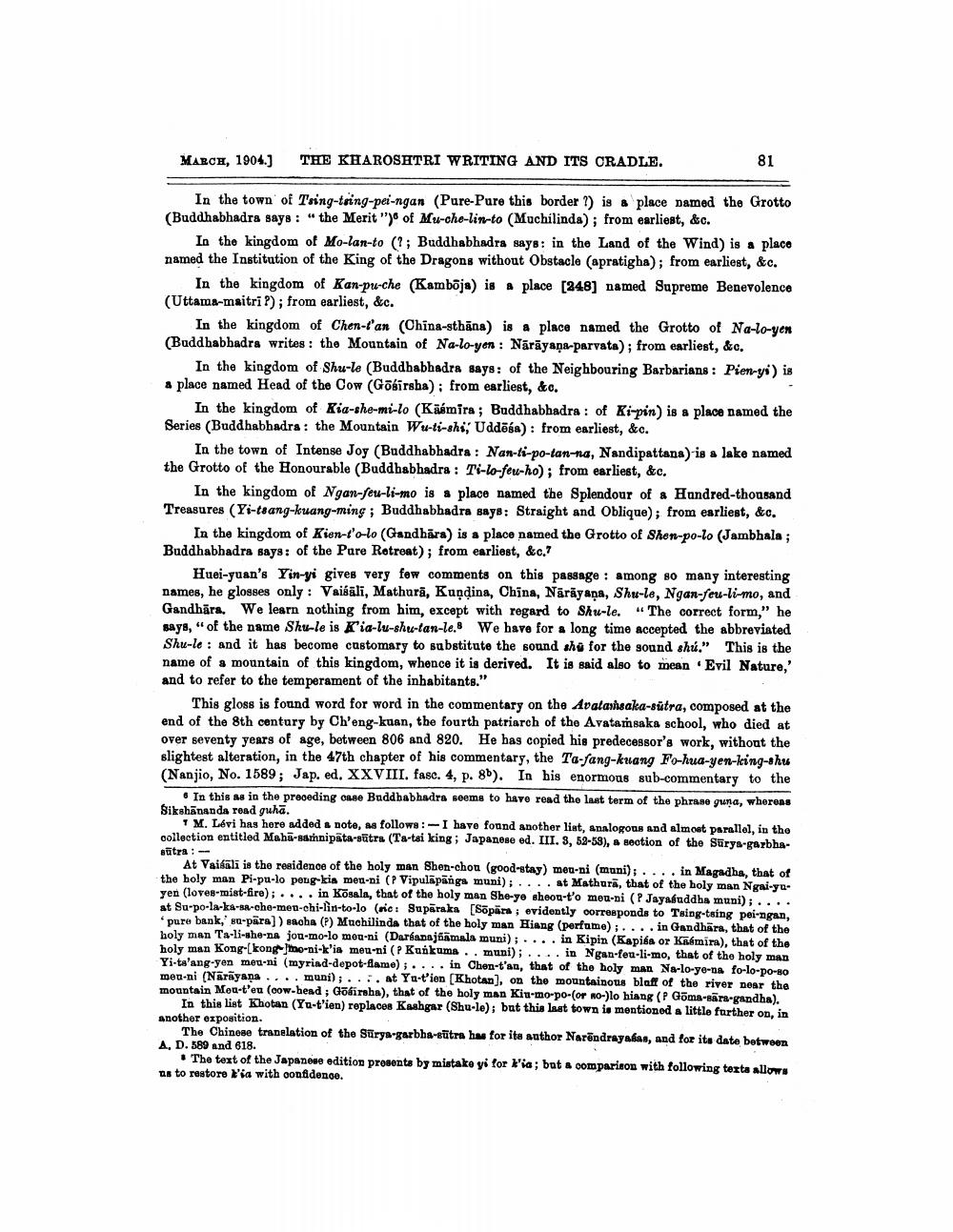________________
MARCH, 1904.] THE KHAROSHTRI WRITING AND ITS CRADLE.
In the town of Tsing-taing-pei-ngan (Pure-Pure this border ?) is a place named the Grotto (Buddhabhadra says: "the Merit") of Mu-che-lin-to (Muchilinda); from earliest, &c.
81
In the kingdom of Mo-lan-to (?; Buddhabhadra says: in the Land of the Wind) is a place named the Institution of the King of the Dragons without Obstacle (apratigha); from earliest, &c.
In the kingdom of Kan-pu-che (Kamboja) is a place [248] named Supreme Benevolence (Uttama-maitri ?); from earliest, &c.
In the kingdom of Chen-t'an (China-sthana) is a place named the Grotto of Na-lo-yen (Buddhabhadra writes: the Mountain of Na-lo-yen: Nārāyaṇa-parvata); from earliest, &c.
In the kingdom of Shu-le (Buddhabhadra says: of the Neighbouring Barbarians: Pien-yi) is a place named Head of the Cow (Gosirsha); from earliest, &c.
In the kingdom of Kia-she-mi-lo (Kasmira; Buddhabhadra: of Ki-pin) is a place named the Series (Buddhabhadra: the Mountain Wu-ti-shi, Uddeśa): from earliest, &c.
In the town of Intense Joy (Buddhabhadra: Nan-ti-po-tan-na, Nandipattana) is a lake named the Grotto of the Honourable (Buddhabhadra: Ti-lo-feu-ho); from earliest, &c.
In the kingdom of Ngan-feu-li-mo is a place named the Splendour of a Hundred-thousand Treasures (Yi-tsang-kuang-ming; Buddhabhadra says: Straight and Oblique); from earliest, &c.
In the kingdom of Kien-t'o-lo (Gandhāra) is a place named the Grotto of Shen-po-lo (Jambhala; Buddhabhadra says: of the Pure Retreat); from earliest, &c.7
Huei-yuan's Yin-yi gives very few comments on this passage: among so many interesting names, he glosses only: Vaisali, Mathura, Kuṇḍina, China, Nārāyana, Shu-le, Ngan-feu-li-mo, and Gandhara. We learn nothing from him, except with regard to Shu-le. The correct form," he says, "of the name Shu-le is K'ia-lu-shu-tan-le. We have for a long time accepted the abbreviated Shu-le and it has become customary to substitute the sound she for the sound shu." This is the name of a mountain of this kingdom, whence it is derived. It is said also to mean Evil Nature,' and to refer to the temperament of the inhabitants."
This gloss is found word for word in the commentary on the Aratahsaka-sutra, composed at the end of the 8th century by Ch'eng-kuan, the fourth patriarch of the Avataṁsaka school, who died at over seventy years of age, between 806 and 820. He has copied his predecessor's work, without the slightest alteration, in the 47th chapter of his commentary, the Ta-fang-kuang Fo-hua-yen-king-shu (Nanjio, No. 1589; Jap. ed. XXVIII. fasc. 4, p. 8b). In his enormous sub-commentary to the
In this as in the preceding case Buddhabhadra seems to have read the last term of the phrase guna, whereas Sikshananda read guha.
M. Lévi has here added a note, as follows:- I have found another list, analogous and almost parallel, in the collection entitled Maha-samṁnipäta-sutra (Ta-tai king; Japanese ed. III. 3, 52-53), a section of the Surya-garbha
sutra: --
At Vaisali is the residence of the holy man Shen-chou (good-stay) meu-ni (muni); . . . . in Magadha, that of the holy man Pi-pu-lo peng-kia mea-ni (? Vipulapanga muni); .... at Mathura, that of the holy man Ngai-yuyen (loves-mist-fire); .... in Kosala, that of the holy man She-ye sheou-t'o meu-ni (? Jayasuddha muni); .... at Su-po-la-ka-sa-che-men-chi-lìn-to-lo (sic: Suparaka [Sopara; evidently corresponds to Tsing-tsing pei-ngan, 'pure bank, su-para]) sacha (P) Muchilinda that of the holy man Hiang (perfume); . . . . in Gandhara, that of the holy man Ta-li-she-na jou-mo-lo meu-ni (Daréanajñāmala muni); .... in Kipin (Kapisa or Kaémira), that of the holy man Kong-kong-mo-ni-k'ia meu-ni (? Kunkuma.. muni); ... in Ngan-feu-li-mo, that of the holy man Yi-ta'ang-yen meu-ni (myriad-depot-flame); .... in Chen-t'an, that of the holy man Na-lo-ye-na fo-lo-po-so men-ni (Narayana.... muni);... at Yu-t'ien [Khotan], on the mountainous blaff of the river near the mountain Meu-t'eu (cow-head; Gofiraha), that of the holy man Kiu-mo-po-(or no-)lo hiang (P Gōma-sara-gandha). In this list Khotan (Yu-t'ien) replaces Kashgar (Shu-le); but this last town is mentioned a little further on, in another exposition.
The Chinese translation of the Surya-garbha-sutra has for its author Narendrayadas, and for its date between A, D. 589 and 618.
The text of the Japanese edition presents by mistake yi for k'ia; but a comparison with following texts allows us to restore t'ia with confidence.




